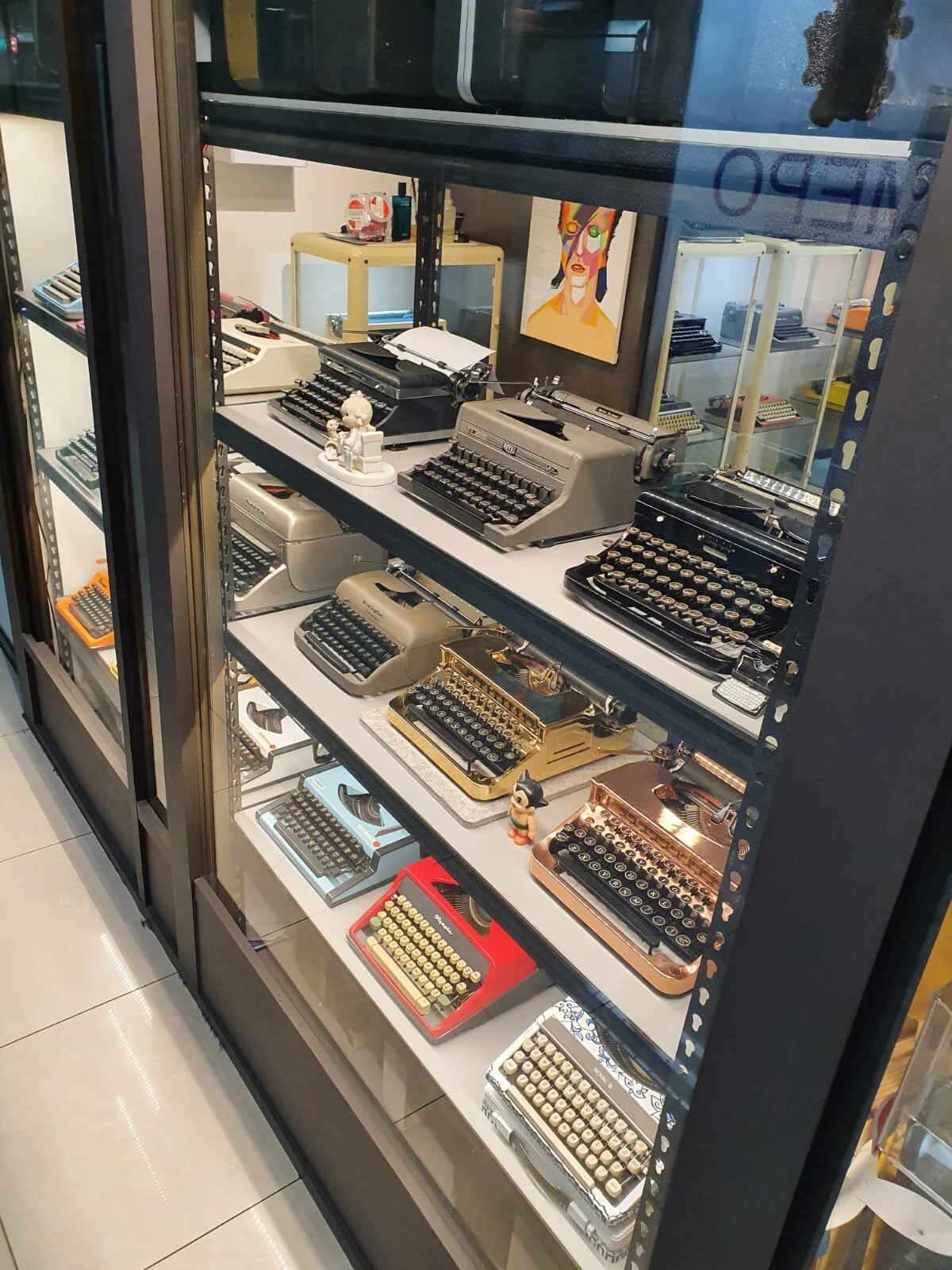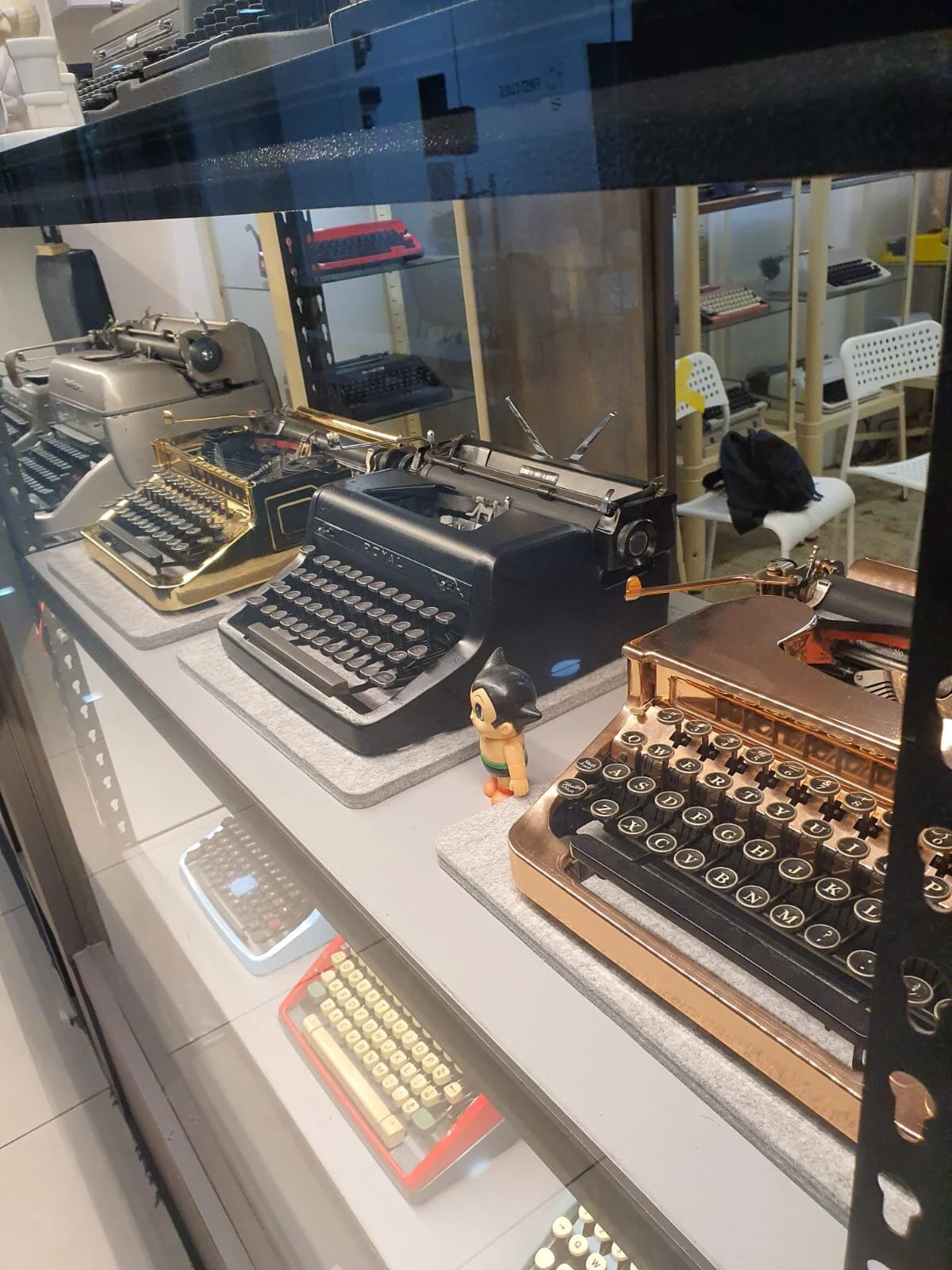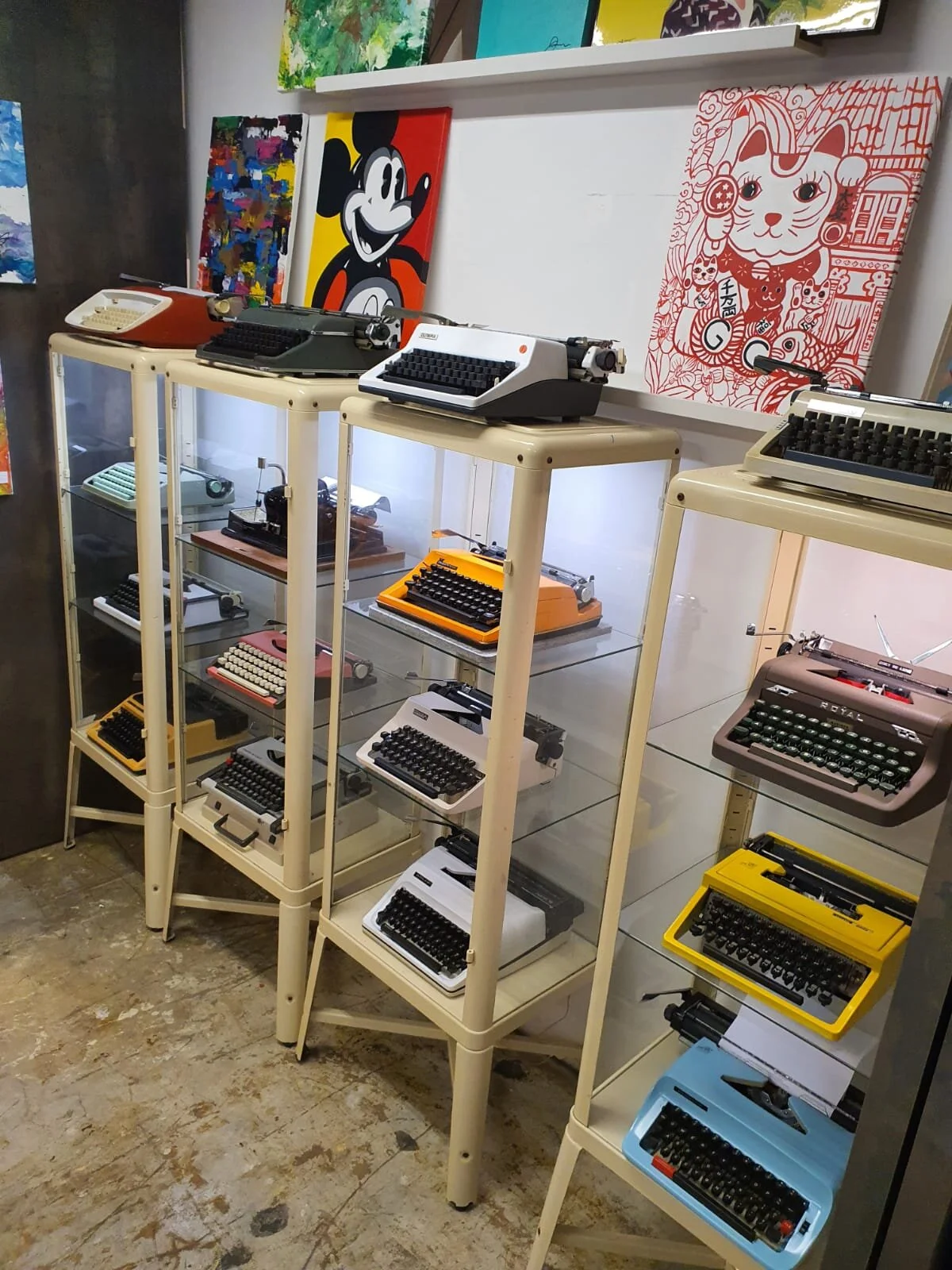Retail
This is the page description.
Retail
— Typewriter Brands —
This is a stocklist of the brands we carry
Royal
— The Royal Typewriter Company — was founded in January 1904 in a machine shop in Brooklyn, New York by Edward B. Hess and Lewis C. Myers. In 1905, with their limited cash running out, Hess and Myers turned to Thomas Fortune Ryan, the wealthy financier. They demonstrate their machine which has numerous innovations including: friction-free, ball-bearing, one-track rail to support the weight of the carriage, a new paper feed, a lighter and faster typebar action with complete visibility of the words as they are typed. Ryan is impressed and puts up $220,000 in exchange for financial control.
In March 1906 the first Royal typewriter, the Royal Standard, was sold. The Royal Standard was different from its competition in that it had a “flatbed” design rather than the traditional “upright” design used by other typewriter manufacturers. With demand increasing, Royal purchased 5¼ acres in Hartford, Connecticut as the new site for its manufacturing facility. Original plans called for floor capacity of 250,000 square feet and will cost $350,000 to build. In 1908, Royal will begin manufacturing here. In 1911, Royal introduced the Royal 5 typewriter which also utilized the “flatbed” design.
Royal’s first model utilizing the “upright” design was the Royal 10 which came out in 1914. Original models had two beveled glass panes on each side. The Royal 10 was an immediate success. In 1926 Royal introduced the “Roytype” brand name for its line of typewriter ribbons and carbon paper. Royal’s introduction of its portable line of typewriters in the late 1920’s was an immediate success and launched the company to become the world’s #1 selling typewriter brand.
To promote the ruggedness of its typewriters, George Edward Smith, president of Royal bought a Ford-Stout tri-motor airplane in August 1927. This plane will drop over 200 typewriters in crates with parachutes to dealers over the eastern seaboard of the USA. Royal will eventually deliver over 11,000 this way with only 10 being damaged.
In January 1941, Edward B. Hess, one of Royal’s founders and vice presidents, died in Orlando, Florida. Hess was a prolific inventor and held over 140 patents relating to the typewriter.
World War II brought tremendous change to Royal. In order to aid the war effort, Royal converted its manufacturing to war work exclusively. Royal would manufacture machine guns, rifles, bullets, propellers, and spare parts for airplane engines. It wouldn’t be until September 1945 that Royal would start typewriter production full-time again.
In 1947, Royal would produce, in limited quantity, a gold-plated version of its popular Quiet Deluxe model. Ian Fleming, the British novelist who wrote the James Bond novels, would use one. Other typewriter manufacturers would utilize Royal’s innovations in their typewriters. In 1947, Royal would win patent suits against Remington and LC Smith & Corona. In February 1950, Royal introduced its first electric typewriter.
Underwood
— The Underwood Typewriter Company —
was a manufacturer of typewriters headquartered in New York City, New York. Underwood produced what is considered the first widely successful, modern typewriter. By 1939, Underwood had produced five million machines. From 1874, the Underwood family made typewriter ribbon and carbon paper, and were among a number of firms who produced these goods for Remington. When Remington decided to start producing ribbons themselves, the Underwoods opted to manufacture typewriters. The original Underwood typewriter was invented by German-American Franz Xaver Wagner, who showed it to entrepreneur John Thomas Underwood. Underwood supported Wagner and bought the company, recognising the importance of the machine. Underwood No. 1 and No. 2s, made between 1896 and 1900, had "Wagner Typewriter Co." printed on the back. The Underwood No. 5 launched in 1900 has been described as "the first truly modern typewriter". Two million had been sold by the early 1920s, and its sales “were equal in quantity to all of the other firms in the typewriter industry combined”.
When the company was in its heyday as the world's largest typewriter manufacturer, its factory at Hartford, Connecticut was turning out typewriters at the rate of one each minute.Underwood started adding addition and subtraction devices to their typewriters in about 1910.Philip Dakin Wagoner was appointed president of the Elliott-Fisher Company after World War I (1914-1918). Elliott-Fisher became the parent of the Underwood Typewriter Company and the Sundstrand Adding Machine Co. In 1927 Wagoner reorganized the company into Underwood-Elliott-Fisher, which later became the Underwood Corporation. The reorganization was completed in December 1927. John Thomas Underwood was elected chairman and Wagoner president of Underwood Elliott-Fisher. In the years before World War II, Underwood built the world's largest typewriter in an attempt to promote itself. The typewriter was on display at Garden Pier in Atlantic City, New Jersey for several years and attracted large crowds. Often, Underwood would have a young woman sitting on each of the large keys. The enormous typewriter was scrapped for metal when the war started.
During World War II, Underwood produced M1 carbines. Approximately 540,000 M1 Carbines were produced from late 1942 to May of 1944. Underwood also produced M1 Carbine barrels for the US Government. Under the Free Issue Barrel Program, barrels were sent to other prime manufacturers who did not possess the machines to make barrels. It is thought that they made about 1 million barrels from late 1942 to late 1944. During the post-war period they were one of two civilian companies who were awarded a contract to refurbish M1 Carbines. They were first to produce stamped and brazed parts by producing trigger housings and front sights reducing time and machines for complex work during milling operations.In 1945 Wagoner was elected chairman of the board of Underwood, and Leon C. Stowell was elected president. Wagoner remained chief executive.
Olivetti bought a controlling interest in Underwood in 1959, and completed the merger in October 1963, becoming known in the US as Olivetti-Underwood with headquarters in New York City, and entering the electromechanical calculator business. The Underwood name last appeared on Olivetti portable typewriters produced in Spain in the 80s.
Olympia
— The Olympia —
Olympia’s story begins in Berlin on August 15, 1903. Here, under the direction of European General Electric (AEG), Dr. Friedrich von Hefner-Alteneck sought to develop a German machine to capitalize on the rising popularity and demand for typewriters. The result was the Mignon, a roller-type typewriter that didn’t fare well, as it was too expensive for many potential customers.
AEG continued to hammer away at the problems, however, finally starting full-scale production of the new, improved Mignon “AA” line in 1912. The first commercially successful Olympia, the Model 3, rolled into the marketplace just under nine years later, and two years after that, in 1923, the company set up shop in Erfurt, Germany.
By 1930, the Olympia brand name had been secured, in honor of the very last Mignon model produced, the Olympia Plurotyp of 1933. The Model 7 and Model 8 machines produced at this time, however, were sold under both the AEG and Olympia names. Later prototypes of the 1930s, including the 8a and 8b models, were simpler and cheaper, and gained popularity in the market--although a few lines, like the Filia and Super, did not last long before being pulled.
Necessary Moves
By 1943, Olympia typewriters were selling quite well, and the company had even created a one-handed version of the Model 8, for disabled users. But all was not well. As World War II raged over the European skies, the Erfurt plant suffered damage. Already reduced to just eleven employees by April of 1945, the factory survived the bombing and capture of the city by Allied forces. However, it was greatly tested by the Soviet takeover later that summer, as the East German government took control of Erfurt and everything in it--including Olympia--renaming the company “Optima”.
Several former employees fled to West Germany, though, and set up shop in 1948 in Wilhelmshaven, where Olympia typewriters continued to be made until production stopped in 1992.
Postwar Heyday
From the late nineteen forties onward, Olympia enjoyed increasing success. First, in 1949, the International Court of Justice at The Hague settled the dispute between East and West Germany over rights to the Olympia brand name. The Wilhelmshaven owners won, and officially changed the name of the company to Olympia Werke.
By 1961, about half of the typewriters in use in Germany were Olympia portables. From the popular Progress, Simplex, and Elite models to the SM2, SM3, and SF Portable--all of which maintained continuous production for sixteen years or more, from the 1950s through the 1970s--Olympia portable typewriters were known for craftsmanship, eye-catching design, and continuous innovation. Although some models never took off as planned (for example, the Orbis, which only lasted one year before being discontinued), features such as individually-spring-loaded keys provided extra comfort and cushioning, bringing in customers despite the high price point of Olympias. (In 1964, an Olympia SM7 cost $142.50--quite a hefty price tag, as this amounts to over $1,000 in today’s currency!) Even as close competitors Remington and Underwood were bought out by other companies, Olympia continued to thrive, opening new manufacturing facilities in Canada, Ireland, Mexico, and Chile, just to name a few countries.
It was during this time that Olympia produced some of its most popular models, including the SM5, which came in mod colors like caramel, mint aquamarine, and pink, and offered a script-typing option. Olympia typewriters even began to turn up in Hollywood, as Alfred Hitchcock’s 1964 thriller Marnie features Tippi Hedren as a crazed secretary, typing away and having neurotic episodes behind an Olympia SG3!
Changing Times
By the 1970s, Olympia--like most other business machine suppliers--was well aware of the threat computers presented to typewriters. Eventually, the company would branch out into calculators and computers, but before doing so, it tried many different innovations and improvements to the existing product. In 1970, Olympia introduced the SGE 50M Excellence, an electric typewriter that used proportional spacing, much like the computers of today. The firm also experimented with Dvorak keyboards, which placed the most commonly-used letters in the English alphabet more conveniently and comfortably than the standard QWERTY format. And, in 1984, even as computers took over the business world, the company kept pushing the envelope; it debuted its Olympia 1011, an important improvement over the traditional Chinese-language typewriter. Instead of the individual keys for over 2,500 characters conventionally used, the 1011 featured electrically-controlled inkjets that specially formed each character without time-consuming adjustments.
However, none of these models lasted long. The SGE 50M was only in production for three years, from 1970 until 1972, and the Dvorak machines were too expensive, costing over $300 more than a regular QWERTY typewriter.
Modern-Day Olympians
In the end, Olympia folded. Production ended in 1992, after every attempt to save the company. But Olympia typewriters are still around, often in great condition and highly prized by their owners.
Today, Olympias are especially cherished by professional wordsmiths, including Paul Auster, author of The Invention of Solitude and Man in the Dark: A Novel, among other books. His 2002 art book--The Story of My Typewriter, with painter Sam Messer--is a tribute to his SM9 manual Olympia.
So if you are interested in a machine once called the “Mercedes-Benz of typewriters”, available in great condition and a wide variety of styles and colors, check out an Olympia. You won’t regret it. And chances are, you can still buy an Olympia and “buy American”--if you find the right seller, that is!
Remington
— E. Remington and Sons —
E. Remington and Sons (1816–1896) was a manufacturer of firearms and typewriters. Founded in 1816 by Eliphalet Remington in Ilion, New York, on March 1, 1873 it became known for manufacturing the first commercial typewriter.There are two versions of the origin story of the first Remington rifle barrel. One holds that the younger Remington wanted to purchase a rifle and lacked the money to buy one so he made his own. The other states that he forged a barrel from wrought iron to see if he could build a better rifle than he could buy. Both versions have him taking the barrel to a gunsmith to have it rifled. Eliphalet II forged his first rifle barrel as a young blacksmith in 1816 and finished second place in a local shooting match with it. Despite not winning the match, he proceeded to make barrels to meet the growing demand for flintlock rifles in the Mohawk Valley. With the completion of the Erie Canal, connecting Buffalo with Albany, commerce in the Mohawk Valley expanded remarkably as did the demand for rifle barrels.
To meet the increased demand for rifle barrels, in 1828 the Remingtons moved their forge and foundry from its rural setting to 100 acres (0.4 km²) of land they had purchased astride the canal and abutting the Mohawk River near a town then called Morgan's Landing (later Ilion), New York. The move coincided with the elder Eliphalet's death, and Eliphalet II assumed control of the business. In 1839 Eliphalet was joined by his oldest son, Philo Remington (to make the business "E. Remington & Son"), and in 1845 his second son, Samuel, also joined the company, afterwards called "E. Remington & Sons". Remington's third son, Eliphalet III, would later join the company as well. During this period, the Remingtons specialized almost exclusively in the manufacture of rifle barrels. These barrels, marked with the distinctive "REMINGTON" stamp near their breeches, were recognized for their quality and reasonable price. Many, if not most, of the independent gunsmiths in the Mohawk Valley purchased completed (but not rifled) barrels from Remington and assembled them into firearms custom ordered by their customers.
As demand increased, the Remingtons added other parts to their inventory, first percussion locks made in Birmingham, England but marked with their stamp "REMINGTON", and later sets of brass gun furniture, including trigger guards, butt plates, and patch boxes. After 1846, first martial longarm and then revolver production dominated the company's workforce. In 1848, the company purchased gun making machinery from the Ames Manufacturing Company of Chicopee, Massachusetts, and took over a contract for Jenks breechloading percussion carbines for the U.S. Navy. Remington supplied the U.S. Navy with its first breech-loading rifle. Remington supplied the U.S. Army with rifles in the Mexican–American War (1846 to 1848). Shortly after, Remington took over a defaulted contract (by John Griffith of Cincinnati) for 5,000 U.S. Model 1841 Percussion Mississippi rifles. Based on the success of filling these orders, subsequent contracts followed in the 1850s. In 1856 the business was expanded to include the manufacture of agricultural implements. Upon Eliphalet's death in 1861, his son, Philo, took over the firm during the Civil War, and diversified the product line to include sewing machines (manufactured from 1870 to 1894) and typewriters (1873), both of which were exhibited at the Centennial Exposition in Philadelphia in 1876.On June 23, 1868 a patent was granted to Christopher Sholes, Carlos Glidden, and Samuel W. Soule for a "Type-Writer" which was eventually developed into the Sholes and Glidden typewriter, the first device that allowed an operator to type substantially faster than a person could write by hand.
The patent (U.S. 79,265) was sold for $12,000 to Densmore and Yost, who made an agreement with E. Remington and Sons (then famous as a manufacturer of sewing machines), to commercialize what was known as the Sholes and Glidden Type-Writer. Remington started production of their first typewriter on March 1, 1873 in Ilion, New York. The Type-Writer introduced the QWERTY, designed by Sholes, and the success of the follow-up Remington No. 2 of 1878 – the first typewriter to include both upper and lower case letters via a shift key – led to the popularity of the QWERTY layout.
— We Adopt Old typewriters too —
Email/call us if you wish to sell your old typewriters.






